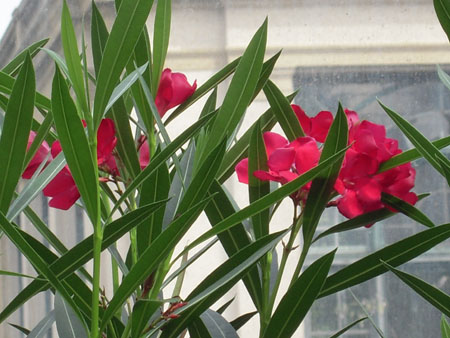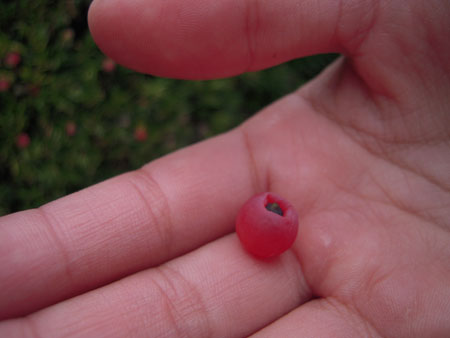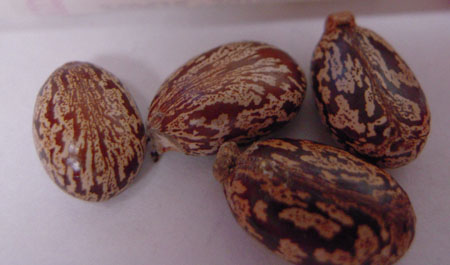Investigations
1st investigations to order
ECG
Test
ECGs of patients who have ingested monkshood, lily of the valley, foxglove, oleander, milkweed, red squill, blue cohosh, poison hemlock, golden chain, Indian tobacco, lupin, green tea, yerba mate, bala, or ma huang may show dysrhythmias.
ECGs of patients who have ingested monkshood, lily of the valley, foxglove, oleander, milkweed, or red squill may show bradydysrhythmias with/without heart block.
ECGs of patients who have ingested blue cohosh, poison hemlock, golden chain, Indian tobacco, lupin, laburnum tobacco, green tea, yerba mate, bala, ma huang, or khat may show tachydysrhythmias.
ECGs of patients who have ingested yew leaves or seeds may show ventricular dysrhythmias.[Figure caption and citation for the preceding image starts]: OleanderFrom private collection of Gerald O'Malley [Citation ends]. [Figure caption and citation for the preceding image starts]: YewFrom private collection of Gerald O'Malley [Citation ends].
[Figure caption and citation for the preceding image starts]: YewFrom private collection of Gerald O'Malley [Citation ends]. [Figure caption and citation for the preceding image starts]: YewFrom private collection of Gerald O'Malley [Citation ends].
[Figure caption and citation for the preceding image starts]: YewFrom private collection of Gerald O'Malley [Citation ends].
Result
normal, tachydysrhythmias, bradydysrhythmias ± heart block, or ventricular dysrhythmia
FBC
Test
Patients who have ingested autumn crocus, meadow saffron, Madagascar periwinkle, North American mayapple, Podophyllum species, castor bean, or ackee fruit may have bone marrow suppression.
Patients who have ingested sweet vernal grass, tonka beans, bedstraw, sweet clover, red clover, or horse chestnut may have severe bleeding.[Figure caption and citation for the preceding image starts]: Castor beanFrom private collection of Gerald O'Malley [Citation ends].
Result
low Hb due to bone marrow suppression or severe bleeding; low WBC count and platelets suggests bone marrow suppression
serum electrolytes
Test
May aid in the evaluation of plant-induced gastroenteritis.
Result
plant-induced gastroenteritis: hyper- or hyponatraemia, hypochloraemia, reduced bicarbonate
serum creatinine
Test
May be noted in patients who have ingested Aristolochia species or soluble oxalate-containing plants.
Result
plant-induced renal failure
serum lactate
Test
May be noted in patients who have ingested cyanogenic plants, such as Prunus species.
Result
plant-induced acidosis
serum urea/creatinine
Test
May aid in the evaluation of dehydration due to plant-induced gastroenteritis.
Result
may show dehydration: ratio >20:1
liver function tests
Test
May assist the evaluation and treatment of plants that contain hepatotoxic alkaloids or other hepatotoxins.
Result
may show: elevated >2-3 times normal
INR
Test
May assist the evaluation and treatment of plant-induced coagulopathy.
Result
may show: elevated >1
ABG
Test
Acidosis can occur with complete chewing of certain seeds; cassava (Manihot esculenta) and Prunus species contain cyanogenic glycosides amygdalin and linamarin, respectively, which are released when seeds are chewed.[26]
Result
may show: acidosis due to ingestion of cyanogenic glycoside-containing plants or post plant-induced seizure
chest x-ray
Test
Patients who have ingested betel nut, calabar bean (ordeal bean), Sabah vegetable, or pilocarpus plants may have evidence of non-cardiogenic pulmonary oedema (depending on severity).
Result
muscarinic plants: normal or pulmonary oedema
Investigations to consider
troponin
Test
May be noted in patients who have ingested colchicine-containing plants.
Result
elevated levels prognostic for cardiac failure
serum digoxin levels
Test
Serum digoxin levels may be positive after ingestion of cardiac glycoside-containing plants, but due to differences in binding affinity to the assay, levels are not useful and treatment is determined according to symptom severity. Negative results may occur despite ingestion of cardiac glycoside.
Result
may be positive in cases of ingestion of cardiac glycoside-containing plants
response to physostigmine
Test
Physostigmine may be useful in antimuscarinic plant poisoning as a diagnostic aid, when the aetiology of the patient's fever, tachycardia, and altered mental status are unknown. A response to physostigmine can help differentiate between an antimuscarinic poisoning and another aetiology such as infection or poisoning via a sympathomimetic. Physostigmine may be used as treatment and may control agitation more effectively than benzodiazepines.[36] Physostigmine is not commercially available in the US, but it may be available via a temporary importation service via the Food and Drug Administration.[38][39] Physostigmine may also not be available in other countries; consult your local drug formulary.
Result
reversal of symptoms in cases of antimuscarinic plant ingestion
Use of this content is subject to our disclaimer